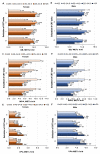Do Physical Activity, BMI, and Wellbeing Affect Logical Thinking?
- PMID: 35682215
- PMCID: PMC9180028
- DOI: 10.3390/ijerph19116631
Do Physical Activity, BMI, and Wellbeing Affect Logical Thinking?
Abstract
We studied 6368 people (4544 women and 1824 men; aged 18-74 years). The research goal was to determine whether the Cognitive Reflection Test score (logical thinking compared with intuitive thinking) depends-and in what way it depends-on the healthy lifestyle components and emotional health-related components as well as age (18-74 years) and gender. We established that analytical vs. intuitive thinking depended on components of a healthy lifestyle, physical activity, sleep, eating habits, smoking and alcohol consumption, specificity of sporting activity, body mass index, and emotional health-related components (stress, depression, impulsivity, subjective health, emotional intelligence), as well as age and gender. We found that logical thinking was not associated with sleep, moderate-to-vigorous PA, impulsivity, subjective health, and components of a healthy lifestyle. However, logical thinking decreases with age, gender (higher in men than in women), BMI (decreases in both genders over the second degree of obesity), depression (the more severe depression in women, the worse their logical thinking), sedentary behavior (people who sat for longer periods had more difficulty solving problems), and in professional sportswomen (logical thinking is worse in professional sportswomen than in sedentary women, amateur sportswomen, or women who use gyms). Finally, we determined inverse correlations between logical thinking, emotional intelligence, and stress.
Keywords: emotional intelligence; healthy lifestyle; logical thinking; mental health; physical activity; professional athletes.
Conflict of interest statement
The authors declare no conflict of interest.
Figures








Similar articles
-
Men and women choose moderate-to-vigorous physical activity and sedentary behaviors with a "hot" mind rather than a "cold" one.BMC Public Health. 2024 Dec 3;24(1):3364. doi: 10.1186/s12889-024-20866-2. BMC Public Health. 2024. PMID: 39623386 Free PMC article.
-
Beyond lifestyle, logic and empathy: subjective health, mood, emotional intelligence, and personality as keys to well-being for women and men.BMC Psychiatry. 2025 Mar 11;25(1):222. doi: 10.1186/s12888-025-06639-0. BMC Psychiatry. 2025. PMID: 40069704 Free PMC article.
-
What Types of Exercise Are Best for Emotional Intelligence and Logical Thinking?Int J Environ Res Public Health. 2022 Aug 15;19(16):10076. doi: 10.3390/ijerph191610076. Int J Environ Res Public Health. 2022. PMID: 36011715 Free PMC article.
-
Self-rated health habits, mental health, emotional intelligence, and impulsivity across the Baltic States.Front Public Health. 2025 May 13;13:1522918. doi: 10.3389/fpubh.2025.1522918. eCollection 2025. Front Public Health. 2025. PMID: 40433486 Free PMC article.
-
Physical Activity, Stress, Depression, Emotional Intelligence, Logical Thinking, and Overall Health in a Large Lithuanian from October 2019 to June 2020: Age and Gender Differences Adult Sample.Int J Environ Res Public Health. 2021 Dec 4;18(23):12809. doi: 10.3390/ijerph182312809. Int J Environ Res Public Health. 2021. PMID: 34886535 Free PMC article.
Cited by
-
Men and women choose moderate-to-vigorous physical activity and sedentary behaviors with a "hot" mind rather than a "cold" one.BMC Public Health. 2024 Dec 3;24(1):3364. doi: 10.1186/s12889-024-20866-2. BMC Public Health. 2024. PMID: 39623386 Free PMC article.
-
Beyond lifestyle, logic and empathy: subjective health, mood, emotional intelligence, and personality as keys to well-being for women and men.BMC Psychiatry. 2025 Mar 11;25(1):222. doi: 10.1186/s12888-025-06639-0. BMC Psychiatry. 2025. PMID: 40069704 Free PMC article.
-
The best exercises from top 20 by health-related indicators.Front Public Health. 2025 Mar 25;13:1475618. doi: 10.3389/fpubh.2025.1475618. eCollection 2025. Front Public Health. 2025. PMID: 40201368 Free PMC article.
-
Factors influencing students' happiness, vitality, and self-esteem.Front Psychol. 2024 Dec 10;15:1463459. doi: 10.3389/fpsyg.2024.1463459. eCollection 2024. Front Psychol. 2024. PMID: 39720688 Free PMC article.
-
Physical Activity, Body Image, and Emotional Intelligence Differences in Adults with Overweight and Obesity.Diseases. 2023 May 10;11(2):71. doi: 10.3390/diseases11020071. Diseases. 2023. PMID: 37218884 Free PMC article.
References
-
- Bull F.C., Al-Ansari S.S., Biddle S., Borodulin K., Buman M.P., Cardon G., Carty C., Chaput J.P., Chastin S., Chou R., et al. World Health Organization 2020 guidelines on physical activity and sedentary behavior. Br. J. Sports Med. 2020;54:1451–1462. doi: 10.1136/bjsports-2020-102955. - DOI - PMC - PubMed
MeSH terms
LinkOut - more resources
Full Text Sources
Medical
Research Materials

